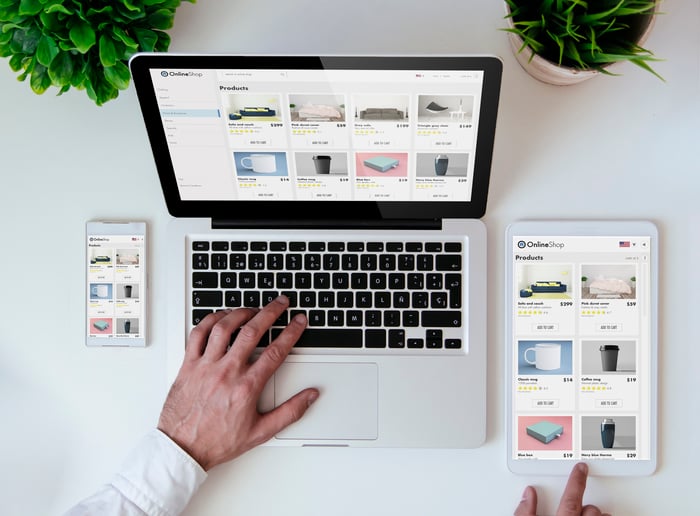There's little doubt that the best path to long-term wealth generation is investing in quality companies and holding them for years, if not decades. But while generating even average returns can make a huge difference, there is a special breed of company that can be a game-changer for investors.
Finding stocks with the right combination of best-in-class offerings, large target markets, and massive over-arching tailwinds can provide life-changing returns that can help set you up in style. Let's look at why Shopify (SHOP -2.37%), Teladoc Health (TDOC -0.07%), and Livongo Health (LVGO) all fit the bill and could help set you up for life.

Image source: Getty Images.
1. Shopify: More than 1 million merchants is just the beginning
After gaining 166% so far this year, you might think that Shopify would be losing steam, but nothing could be further from the truth. As the pandemic took hold, merchants that had long put off setting up e-commerce operations were spurred into action, and Shopify was the clear choice to help them accomplish that transition.
The company not only provides everything merchants need to set up and maintain digital retail operations, but allows them to sell in multiple channels, including web, mobile, social media, online marketplaces, brick-and-mortar locations, and pop-up shops. Shopify also handles all the details, including product management, inventory, payments, and shipping, while also providing value-added services like working capital loans.
Business is booming. During the second quarter Shopify's growth accelerated, with revenue up 97% year-over-year, while subscription revenue climbed 28%, as more merchants joined the platform.
With more than 1 million merchants, Shopify is clearly the industry leader already -- but the opportunity that remains is massive. The company generated revenue of $1.58 billion in fiscal 2019, but that pales in comparison to its total addressable market of $78 billion -- and that's just small- and medium-sized businesses.
Shopify has also been investing heavily in two areas that will drive future growth: Shopify Plus and international expansion. Over the past couple of years, Shopify Plus has created tools aimed at enterprise-level businesses, to great success. The month of June saw record-setting number of merchants joining Shopify Plus.

Image source: Getty Images.
At the same time, Shopify still generates the majority of its revenue in North America, but its international expansion is ongoing. The company closed out 2019 with its international merchant base growing to 29% of its total merchants, up from 24% in 2018.
As more and more merchants join the e-commerce revolution, Shopify has all the key elements of a life-changing investment.
2. Teladoc and 3. Livongo: The best of both worlds
Teladoc Health has been the poster child for companies perfectly positioned to benefit from the stay-at-home orders resulting from the pandemic. The global leader in virtual care provides patients with app-based doctor visits, without the need to venture down to the clinic and risk catching the virus.
Growth in virtual visits vaulted out of the gate this year, producing a commensurate increase in revenue. In the first quarter Teladoc's total patient visits jumped 92%, pushing revenue growth up 41%. If that weren't impressive enough, the second-quarter results exploded higher, with total patient visits that increased 203%, sending revenue up 85%.
For its part, Livongo Health serves a segment of the patient population managing chronic conditions, without the need for the corresponding visits to the doctor's office. There are more than 147 million Americans dealing with at least one chronic condition, according to the company, including diabetes, hypertension, weight management, diabetes prevention, and behavioral health. The ability to use connected devices to help improve quality of life while reducing healthcare expenses has proved to be a win-win, which was reflected in Livongo's results.

Image source: Getty Images.
The company's flagship Livongo for Diabetes program reported enrollment that grew 113% year-over-year in the second quarter, helping drive revenue up by 125%. This came on the heels of 100% enrollment growth and 115% revenue growth in the first quarter.
So why are they listed together? The companies announced in early August that Teladoc Health and Livongo Health would merge, creating "the only consumer centered virtual care platform for full spectrum of health needs to address accelerating consumer and client demand."
Investors initially scoffed at the idea, sending Teladoc and Livongo's stock prices down 26% and 20%, respectively, in the days following the announcement. But on further reflection investors have warmed to the combination, with the stocks regaining much of their initial loses.
Teladoc's management has estimated its total addressable market to be as high as $30 billion. Livongo Health believes the market for diabetes management alone tops out at $16 billion, while the other chronic conditions it addresses represents an additional $18 billion opportunity. This represents a combined addressable market of more than $64 billion. To put that into context, the combined revenue of both companies totaled $724 million for 2019, showing they've just scratched the surface of their respective markets.
Data by YCharts
Every rose has its thorns
It's important to note that commensurate with the high-risk, high-reward nature of these stocks, they also come with high sticker prices, like many high-growth companies. Shopify, Teladoc, and Livongo are selling at 49 times, 18 times, and 38 times forward sales, respectively, when a reasonable price-to-sales ratio is generally between 1 and 2. Additionally, while Shopify generated a profit last quarter, Teladoc and Livongo have yet to do so.
However, investors have thus far been willing to pay up for the impressive top-line growth and the enormous future potential of each of these high-flyers. Considering that each company is growing revenue at or near triple digits, they don't seem nearly that expensive.






